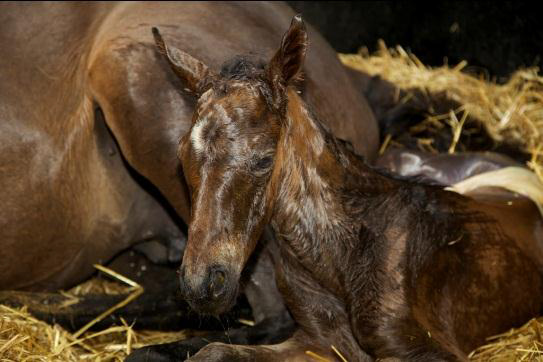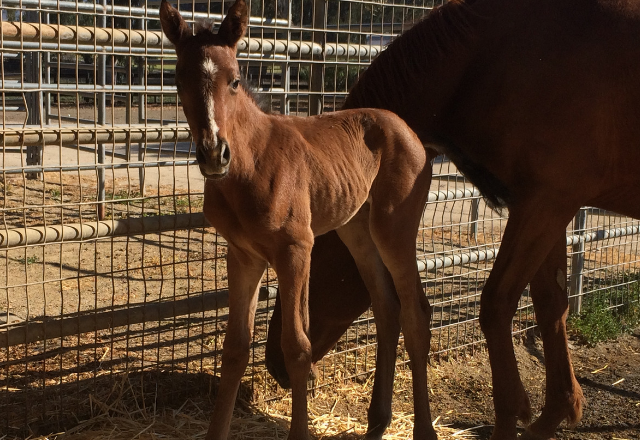It’s foaling time! Now what? Whether you decide to send your horse out to foal or to keep her at home, here are some tips to help you feel more prepared.
THE COUNTDOWN
Now you are getting close to seeing the fruits of your efforts, so lets go down the checklist.
- Vaccinations
- Deworming
- Nutrition
- Dentistry
- Shoes or trimming
- Caslick removal
- Location
Whether you decide to send your horse out to foal or to simply move her into the barn. If they are unfamiliar surroundings, you will want to plan ahead.
Before we get into too much detail, lets think about if you really want to do this yourself. As fun as it is to have a baby at home, many people like the peace of mind of knowing their mare is in a professional facility with round the clock observation. If a foaling goes well, you should find yourself doing little more that crouching in the shadows catching it on video, but being there is important. An unattended foaling carries real risk. It is common belief that foaling “is the most natural thing in the world, they‟ve been doing it for thousands of years without our help.” Very true – but there is another part to that truth. It is also perfectly “natural” to lose a foal or even a mare in the process of foaling in the wild. You just expect a certain mortality rate. In a domestic environment we can do much better than that with just a little bit of knowledge, planning and good judgment.
Many small problems during foaling can be easily corrected with little effort on the attendants‟ part but those same problems can quickly turn ugly if they are missed. Considering that many mares deliver before or even long after their foal date, the commitment to watch your own mare should not be underestimated for its inconvenience. If you do decide to send her out to have her foal, plan on moving her 30 days prior to her expected foaling date so she can get settled in and avoid stress too close to delivery.
If you do decide to keep her at home here are the minimum requirements:
- 12×14 or 12×16 stall. Remember, this is the minimum; once you get a very pregnant mare in there trying to get comfortable, and looking for space to deliver a foal, you will see just how small that stall really is.
- Straw bedding not shavings. Foaling is a wet process and shavings will get into everything including the foals eyes, nose and mouth and the mares vagina and on her bag. And brand new lungs are not equipped to deal with the dust that goes with shavings. Shavings are also known to harbor bacteria.
- Access to electricity and lights and access to a phone.
- A Foaling Kit.
THE FOALING KIT
You will want to have the following items handy at least 30 days before her foaling due date.
- Veterinarians phone # posted close to the foaling area.
- Clean bucket
- Tail wrap or brown gauze (enough to wrap her tail and to tie up her placenta after she foals (your veterinarian needs to see it so you don‟t want her stepping on it).
- Large trash bag for placenta.
- Ivory liquid soap.
- Nolvasan solution diluted 4 to 1 with water and a shotglass or 20cc syringe case (for dipping the navel).
- Roll Cotton or clean face cloth to clean her vulva
- Scissors to cut the gauze.
- Watch or stopwatch to time the stages of labor and notepad and pen to record observations. Record the time labor begins, when your foal is born, when he stands, when he nurses, and when the placenta is delivered.
SHE IS GETTING CLOSE
This is when it gets tricky, frustrating and even comical. There may be clear signs when the time is imminent and then again… First check your dates carefully – take your last breeding date and add 340 days.
Anywhere from a month to a week before foaling you will probably notice her bag (udder) filling and getting larger. Between 1 and 4 days before foaling she may develop waxy looking plugs on her nipples. Don‟t wait for wax to tell you when she is ready, however – it might never come. If she does get wax she may lose the plugs and drip milk (you‟ll see evidence down her legs).
Note: If she drips all the way up to foaling and loses the antibody enriched colostrum or “first milk”, your foal could miss out on essential protection against disease. This condition is called “Failure of Passive Transfer”. Your veterinarian must be notified if this happens because your foal will need replacement colostrum or intravenous plasma.
Other signs that foaling is close are:
- A relaxing of the vulva and a softening around the tail head. This may appear as a “sinking “ of the croup on either side of her tail.
- Voluntary separation from other mares (if she is part of a group).
- Changes in activity – she may be less active, or she may start walking
- Just prior to foaling (within 4 hours) you may notice frequent defecation in small amounts.
Then again, you may see no definitive signs at all. Not only are the physical signs unpredictable, mares appear to have an ability to suppress labor when they feel under scrutiny. Plenty of owners stay up night after night watching their mares sleep and then slip out for 10 minutes to get donuts and return to find a foal on the ground.
You may want to wash her bag with warm water and remove any dirt, mud or excessive smegma (oily skin residue) before the foal nurses.
IT’S TIME!!!
Labor begins.
Stage One: She may almost look like she is a little colicky. She may lie down and get back up a few times or become a bit restless. She may sweat. Then again, (and we are beginning to see a pattern here)…She may not.
Stage Two: The textbook progression of labor should be as follows:
a) Water breaks
b) Presentation of amniotic sack. This should look white, shiny and opalescent. It may appear as a water balloon or it may simply come wrapped around a foot.
c) Presentation of a foot, followed by another. Soles of the feet should be pointing down towards the mares hocks. (Remember: New born hooves are covered in a rubbery layer called deciduous hoof capsule. This is normal.)
Your mare may continue to get up and down until this point. Once she has one or both feet presented she will likely lie flat and begin the real pushing. As long as she is making steady progress she should not need any help. Once the shoulders clear the rest of the body should come quickly. Once delivered your foal may lay with his hind feet still inside the mare – that is fine – you don‟t need to do anything. At this point your mare may take a rest while the foal takes its first breaths and begins to move around.
Although the foal is technically born at this point, the umbilical cord is still attached and continues to deliver blood to the foal. Unless you see a problem with the foal (if the amniotic sack is still over his/her nostrils or he is not moving at all) resist the temptation to rush in. Startling the mare and causing her to get up too soon will mean the cord will break before the blood transfer is complete. As long as your foal is breathing it is a good time for all involved to ….well, to take a breath. Your foal should be moving right away and should rock himself up onto his chest within a minute or so. He will start shivering.
Within a minute or two your mare will probably begin talking to the little wet thing wiggling around behind her and within a few minutes more she will likely stand up to investigate further. This is when the cord will break naturally and it is your chance to sneak in and lift up your foals leg and get to the freshly exposed umbilical stump. Cover the entire navel with your shotglass or syringe case full 25% nolvasan and slosh it around generously. This is also a good time to discover whether you got a filly or a colt. Here‟s a tip. Lift the tail, not the leg. Lots of colts keep their equipment well hidden at first. Look for a vulva, not a penis.
Your mare will probably still have her placenta hanging down between her back legs. If it is lower than her hocks go in quietly and tie some brown gauze to the end of the placenta and then loop it back up and tie it to the top of the placenta just under her vulva so she doesn‟t step on it. You may need to do this again before she passes it completely. She should finish delivering the placenta within 30 minutes to 3 hours after foaling. When she does, pick it up and put it in the plastic bag for your vet to look at later.
During this phase and even for a few hours afterwards, she may experience cramping and seem colicy. This is normal and as long as it is mild she may be able to ride it out without assistance. If she gets too painful, however, and is getting up and down frequently or rolling your veterinarian will need to treat her for the pain. Especially in a small area, a very painful mare could pose a threat to her foal, and at the least she will not be able to stand still to let him/her nurse.
So baby is breathing, up on his chest, shivering and probably attempting his first whinnies. There is not much left to do except watch the little wet drunk try to get to its feet. The temptation to help your foal stand and then guide him to the mares bag will be great. Do yourself a favor and try not to get too heavily involved – you will not only drive yourself crazy, you will probably end up looking like just another part of the comedy act. Within an hour or so your foal should be standing and looking for breakfast. Be prepared – he may try and nurse the mares hock, stifle and elbow before he actually finds the bag. A bowel movement should be coming along soon now too. It may come before or just after the first meal, it may come in stages and it should be dark.
The “New Foal Exam”
At about 10 – 15 hours after foaling your mare should be back into her feed and alternately bonding with and ignoring her baby. You should have a dry fluffy foal that stands and nurses, investigates the stall and naps between meals. All your neighbors have seen it and you might have even picked out a name. Time for the first introduction to your veterinarian.
Your veterinarian will perform a thorough physical exam, look at your foals overall health, assess how his legs are formed and advise you on exercise, listen to his heart, look at his navel etc. In addition your veterinarian will draw a small blood sample to determine if your foal received adequate protection from the mares‟ colostrum. Being able to see what condition the foal arrived in is also important to help your veterinarian determine the foals‟ progress later on.
Call Your Vet if ANY of the Following Events Occur:
“Red Bag” – If you see a dark red velvety protrusion rather than a white amniotic sack your mares placenta has begun detaching prematurely. This can cut off oxygen to your foal and is considered an emergency. You need to get your vet on the way. If this happens take your scissors and cut through the placenta to get to the foal. There is no sensitivity in this tissue and your mare will not feel it. Find the foals legs and be prepared to help get him delivered. If you need to apply traction to his legs remember to keep it steady and even, only pull when she pushes, and pull down towards her hocks rather than straight out. She may take short rests but if she stops pushing for too long, a gentle tug on the foals legs may “spark” the pushing again.
Dystocia – This literally means malpresentation. If you get anything other than an orderly progression of a foot, followed by another foot, followed by a nose, followed by a whole foal, you could have a dystocia. Any presentation other than toes down, soles down, is abnormal and your veterinarian should be called.
Stalled Delivery – If things seem to be in the right order but along the way everything stops – you could have a problem. She may have to work to get her foal delivered but there should be continuous progress. Some mares, especially older ones, simply „run out of gas‟ and require oxytocin and assistance top complete the delivery.
Unreponsive Foal. – Your foal should begin breathing immediately after delivery. If your foal is not taking breaths, rock him up onto his chest and rub him vigorously with a towel while someone contacts your vet. Make sure his nostrils are clear of debris and fluid. Sometimes tickling the inside of the nostril with a piece of straw can be powerful stimulus to initiate breathing.
Retained Placenta – If the placenta is not completely delivered within a couple of hours, your mare could be at risk of infection that could lead to laminitis and other serious conditions. This warrants the attention of your veterinarian.
Some simple things to remember:
1. Vaccinate your mare 300 days before delivery.
2. Have an adequate Foaling Kit
3. Know your mare and watch for signs of impending delivery.
4. Have a truck and trailer hooked up and ready to go to the hospital for an emergency.
5. Have a clean, safe, QUIET and dry place for the mare to deliver.
6. Once the water has broken, delivery should happen very quickly (20 minutes or so).
7. Once the foal has been normally delivered the foal should try and stand (1 hour) and nurse (2 hours) and the placenta should be passed in less than 3 hours (The 1, 2 & 3 rules).
8. Call your veterinarian if you notice any unusual symptoms.



[…] viagra 50mg price costco […]